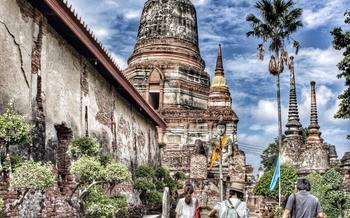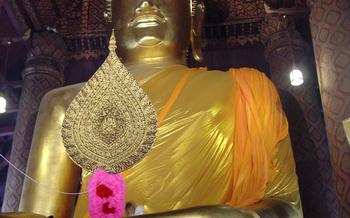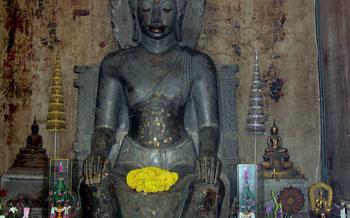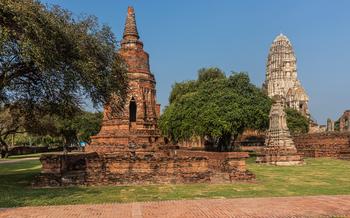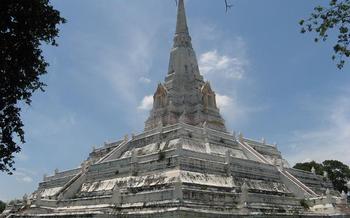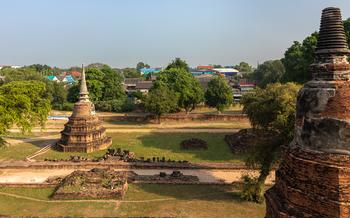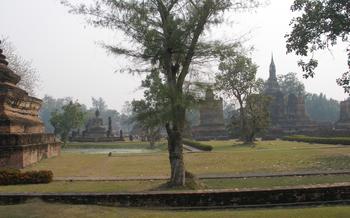
Wat Pradoem
- Historical Background
- Stunning Architecture
- Sacred Buddha Images
- Peaceful Ambiance
- Prayer and Meditation
- Local Festivals and Ceremonies
- Ordination Hall and Monks' Quarters
- Almsgiving and Merit-Making
- Community Involvement
- Local Markets and Street Food
- Nearby Attractions
- Accommodation and Dining Options
- Photography Opportunities
- Respectful Behavior
- Insider Tip
Historical Background
Wat Pradoem, nestled in the tranquil town of Chumphon, Thailand, is a historical and spiritual landmark that holds immense significance in the region. Its origins can be traced back to the 17th century, during the reign of King Narai the Great of the Ayutthaya Kingdom. It is believed that the temple was initially established as a small hermitage by a group of wandering monks seeking refuge and isolation. Over time, the hermitage grew in popularity, attracting devotees and pilgrims from nearby villages, eventually evolving into the grand temple it is today.
As a religious center, Wat Pradoem played a pivotal role in the community, providing a place for worship, meditation, and spiritual guidance. It became a focal point for religious ceremonies, festivals, and ordinations, fostering a deep connection between the temple and the local community. The temple's architectural style, with its intricate carvings and vibrant murals depicting scenes from Buddhist mythology, reflects the artistic and cultural heritage of the Ayutthaya period. Wat Pradoem stands as a testament to the enduring legacy of Thai craftsmanship and spirituality, preserving the essence of a bygone era.
Stunning Architecture
Wat Pradoem's architecture is a testament to the artistry and devotion of its builders. The temple's design follows the traditional Thai style, featuring intricate carvings, colorful murals, and Buddhist motifs. The main sanctuary, or ubosot, is adorned with delicate stucco work depicting scenes from the Buddha's life and teachings. The roof is supported by massive teak pillars, each carved with intricate designs. The temple's interior is equally impressive, featuring a series of murals depicting the Jataka tales, stories of the Buddha's past lives. These murals are considered masterpieces of Thai art and are a must-see for visitors to the temple. The temple's architecture is not only aesthetically pleasing but also holds deep religious significance. The layout and arrangement of the buildings are designed to create a sense of harmony and balance, reflecting the Buddhist teachings of peace and tranquility.
Sacred Buddha Images
Wat Pradoem is home to a collection of revered Buddha images that hold immense religious and historical significance. The most notable among them is the Phra Buddha Chedi Butsathan, a 15-meter-tall standing Buddha statue. This majestic statue exudes an aura of serenity and compassion, with its intricate carvings and gold leaf embellishments. Visitors are often awestruck by its sheer size and beauty.
Another remarkable Buddha image is the Phra Buddha Sihing, a replica of the original Phra Buddha Sihing, which is enshrined in Wat Phra Si Ratana Mahathat in Phitsanulok. This replica is highly revered by the local community and is believed to possess miraculous powers. Devotees often come to pay homage and seek blessings from this sacred statue.
The temple also houses several smaller Buddha images, each with its unique features and attributes. These images represent different aspects of the Buddha's teachings and are objects of devotion for many Thai Buddhists. Some of the most notable smaller Buddha images include the Phra Buddha Nimit, known for its serene expression, and the Phra Buddha Trai Ratana, which represents the Three Jewels of Buddhism: the Buddha, the Dharma, and the Sangha.
Peaceful Ambiance
Wat Pradoem radiates an atmosphere of serenity and tranquility, inviting visitors to find inner peace and spiritual connection. The temple's lush greenery, meticulously landscaped gardens, and tranquil surroundings create a sanctuary of peace amidst the bustling city. The gentle sound of water flowing from the fountains, the rustling of leaves in the breeze, and the melodious chanting of monks add to the serene ambiance.
Stepping into the temple grounds, visitors are immediately enveloped by a sense of calm. The lush vegetation, including towering trees, fragrant flowers, and manicured lawns, provides a refreshing contrast to the urban landscape. The temple's gardens are designed with meticulous care, featuring intricate pathways that wind through vibrant blooms and serene ponds.
The peaceful ambiance of Wat Pradoem is not only a result of its natural surroundings but also a reflection of the temple's spiritual significance. According to Buddhist teachings, peace and tranquility are essential for cultivating mindfulness and achieving enlightenment. The temple's serene atmosphere provides an ideal setting for meditation and contemplation, allowing visitors to escape the distractions of daily life and connect with their inner selves.
Whether seeking solace, spiritual connection, or simply a moment of respite, visitors to Wat Pradoem find a haven of peace and tranquility within its sacred grounds. The temple's serene atmosphere invites them to slow down, breathe deeply, and embrace the present moment, fostering a sense of inner peace and harmony.
Prayer and Meditation
Wat Pradoem serves as a sanctuary for prayer and meditation, inviting devotees to seek inner peace and spiritual connection. Within the temple grounds, designated areas are set aside for these practices, creating a serene and conducive environment. Prayer halls adorned with intricate murals offer a tranquil space for devotees to offer their prayers and devotions. Meditation halls, often nestled amidst lush greenery, provide a secluded retreat for practitioners to find stillness and focus. The teachings of Buddha emphasize the importance of mindfulness, compassion, and self-awareness, and Wat Pradoem offers an ideal setting for practitioners to cultivate these qualities through prayer and meditation. Visitors can observe devotees engaged in these practices, their faces radiating serenity and devotion, creating a palpable sense of spirituality that permeates the temple grounds.
Local Festivals and Ceremonies
Wat Pradoem comes alive during the vibrant festivals and ceremonies that are an integral part of Thai culture and Buddhism. The most significant festival is Songkran, the Thai New Year, celebrated in April. During Songkran, the temple is adorned with colorful decorations, and locals engage in traditional water-splashing rituals to symbolize cleansing and renewal. Another major festival is Visakha Puja, which commemorates the birth, enlightenment, and passing of Buddha. This festival is celebrated in May and features elaborate processions, chanting, and meditation sessions. Visitors can witness these festivals and immerse themselves in the lively atmosphere, experiencing the rich traditions and cultural heritage of Thailand.
Ordination Hall and Monks' Quarters
Within the sacred grounds of Wat Pradoem lies the ordination hall, a significant structure dedicated to the solemn ceremonies of monkhood. Here, young men embark on a spiritual journey, renouncing worldly possessions and embracing the teachings of the Buddha. The ordination hall exudes an air of reverence, with intricate carvings and vibrant murals depicting scenes from the Lord Buddha's life.
The monks' quarters, adjacent to the ordination hall, provide a tranquil abode for the resident monks. These dedicated individuals devote their lives to the pursuit of enlightenment, adhering to strict monastic rules and engaging in daily meditation and study. Visitors are welcome to observe the monks' daily routines, gaining insights into the disciplined and compassionate lifestyle they lead.
Monasticism holds a central place in Thai culture and Buddhism, serving as a symbol of spiritual devotion and moral guidance. The monks at Wat Pradoem play a pivotal role in preserving and transmitting the teachings of the Buddha, inspiring countless individuals on their own spiritual paths.
Almsgiving and Merit-Making
In Thai culture, almsgiving and merit-making hold a significant place. Wat Pradoem serves as a central location for these practices. Devotees gather early in the morning, usually before sunrise, to offer food and other necessities to the resident monks. This act of generosity is believed to bring spiritual merit and good karma to the donors. The monks, in return, chant blessings and offer words of wisdom to the devotees. Participating in an almsgiving ceremony at Wat Pradoem allows visitors to immerse themselves in this sacred tradition and experience the deep sense of reverence and gratitude that permeates the atmosphere.
Community Involvement
Wat Pradoem plays a vital role in the local community, extending its influence beyond religious practices and serving as a hub for social engagement and support. The temple actively participates in various community initiatives, demonstrating the interconnectedness between spiritual and societal well-being.
One of the most significant contributions of Wat Pradoem is its involvement in education. The temple operates a school that provides free education to children from the surrounding communities. The school offers a comprehensive curriculum, emphasizing both academic knowledge and moral values. By providing access to education, Wat Pradoem helps to empower the younger generation and create opportunities for a brighter future.
Furthermore, the temple is engaged in healthcare initiatives, offering medical assistance and support to those in need. Regular health check-ups, vaccination campaigns, and access to affordable medications are provided through the temple's healthcare programs. This commitment to the well-being of the community reflects the Buddhist principle of compassion and the importance of caring for all members of society.
Wat Pradoem also serves as a center for social welfare activities. The temple organizes regular food drives and charity events to support the underprivileged. Donations of food, clothing, and other necessities are collected and distributed to those in need, demonstrating the temple's commitment to social justice and equality.
Through these community initiatives, Wat Pradoem embodies the spirit of Metta, or loving-kindness, which is a core principle in Buddhism. The temple's involvement in education, healthcare, and social welfare programs not only strengthens the local community but also reinforces the interconnectedness of all beings and the importance of compassion and service to others.
Local Markets and Street Food
In the vicinity of Wat Pradoem, visitors can immerse themselves in the vibrant local markets and street food stalls that offer a delightful array of culinary treasures. These markets are a testament to the richness of Thai cuisine and provide an authentic glimpse into the country's culinary traditions. From fresh produce and exotic fruits to fragrant curries and noodle dishes, there's something to satisfy every palate.
One of the must-try dishes is Khao Neeo Mamuang, a sweet and savory combination of sticky rice and ripe mango. Another popular delicacy is Pad Thai, a stir-fried noodle dish with shrimp, chicken, or tofu. Visitors can also indulge in a variety of grilled meats, such as satay and moo ping, which are marinated and cooked to perfection.
For those with a sweet tooth, the markets offer an array of colorful desserts, including mango sticky rice, coconut pancakes, and sweet dumplings. Freshly squeezed juices and tropical smoothies are also popular refreshments to beat the Thai heat.
Navigating the markets can be an adventure in itself. Visitors are encouraged to embrace the bustling atmosphere, interact with the friendly vendors, and sample the exotic flavors that Thailand is renowned for. It's a feast for the senses and a true cultural experience that should not be missed.
Nearby Attractions
In addition to the captivating allure of Wat Pradoem, visitors can delve into a tapestry of nearby attractions that promise unique experiences and cultural immersion.
-
Khao Chong Krajok: Embark on a scenic hike or bike ride through the verdant slopes of Khao Chong Krajok, a national park renowned for its stunning limestone karsts, lush forests, and panoramic views.
-
Than Sadet Waterfall: Immerse yourself in the refreshing cascades of Than Sadet Waterfall, a picturesque natural wonder set amidst a tranquil jungle landscape.
-
Chumphon Night Market: Experience the vibrant sights, sounds, and flavors of the Chumphon Night Market, where vendors showcase a tempting array of local delicacies, handmade crafts, and souvenirs.
-
Koh Tao: Take a short boat trip to the idyllic island of Koh Tao, a diver's paradise famous for its pristine coral reefs, crystal-clear waters, and abundant marine life.
-
Mu Ko Ang Thong National Marine Park: Explore the enchanting archipelago of Mu Ko Ang Thong National Marine Park, boasting a stunning panorama of limestone islands, secluded coves, and pristine beaches.
By combining your visit to Wat Pradoem with these nearby attractions, you can create a comprehensive itinerary that showcases the diverse cultural and natural wonders of Chumphon.
Accommodation and Dining Options
For a comfortable stay near Wat Pradoem, visitors have a range of accommodation options to choose from. The Chumphon Grand Hotel offers modern rooms with stunning city views, while the Niwas Resort features cozy bungalows surrounded by lush gardens. For budget-conscious travelers, the Chumphon Backpackers Hostel provides a friendly and social atmosphere.
When it comes to dining, visitors can savor delicious local cuisine at nearby restaurants and eateries. The Klong Market offers a delightful array of fresh seafood and traditional Thai dishes, while the Rim Nam Restaurant serves mouthwatering curries and rice dishes with a scenic river view. For a taste of international cuisine, the Blue Elephant Restaurant offers a fusion of Thai and Western flavors.
Photography Opportunities
Wat Pradoem offers a feast for the eyes, making it a photographer's paradise. From the intricate carvings adorning the temple's exterior to the serene landscapes surrounding it, there are countless opportunities to capture stunning images.
Best Angles and Lighting:
- Temple Exterior: Position yourself directly in front of the temple to capture its full grandeur. Utilize the morning or late afternoon light for warm and diffused shots.
- Buddha Images: Frame the Buddha images against the ornate backdrop of the temple's interior. Experiment with different angles to highlight their unique features.
- Lush Greenery: Explore the temple grounds and seek out tranquil spots with lush greenery. The interplay of light and shadow creates a magical ambiance.
Camera Settings and Techniques:
- Aperture: For sharp images with a shallow depth of field, use a small aperture (f/8 or higher).
- Shutter Speed: Opt for a fast shutter speed (1/125 or faster) to avoid motion blur when photographing moving subjects.
- Composition: Experiment with different compositions to create dynamic and visually appealing images. Utilize leading lines, rule of thirds, and negative space.
Share Your Photos:
- Social Media: Share your stunning shots on social media using relevant hashtags to connect with other travel enthusiasts.
- Online Galleries: Consider creating an online gallery or blog to showcase your Wat Pradoem photography and inspire others.
Respectful Behavior
When visiting Wat Pradoem, it is crucial to observe respectful behavior, as it is a sacred religious site. Visitors should dress modestly, covering their shoulders and knees, and avoid wearing revealing or offensive clothing. It is customary to remove one's shoes before entering the temple's main buildings, and to walk barefoot or in socks. Silence should be maintained within the temple grounds, as loud noises and chatter can be disruptive to the serene atmosphere. Visitors should also refrain from pointing their feet towards Buddha images, as this is considered disrespectful. When interacting with the monks, it is important to be polite and respectful, and to avoid touching them or their belongings. By observing these cultural norms and customs, visitors can show their respect for Thai culture and religion, and contribute to a peaceful and harmonious environment at Wat Pradoem.
Insider Tip
For a truly unique experience, venture beyond the main temple complex and explore the hidden corners of Wat Pradoem. Discover the secluded meditation caves tucked away in the surrounding hills, where you can find peace and tranquility amidst nature. These caves offer a serene setting for introspection and spiritual connection, allowing you to immerse yourself fully in the temple's sacred atmosphere. Remember to bring a flashlight or headlamp to navigate the caves safely.

